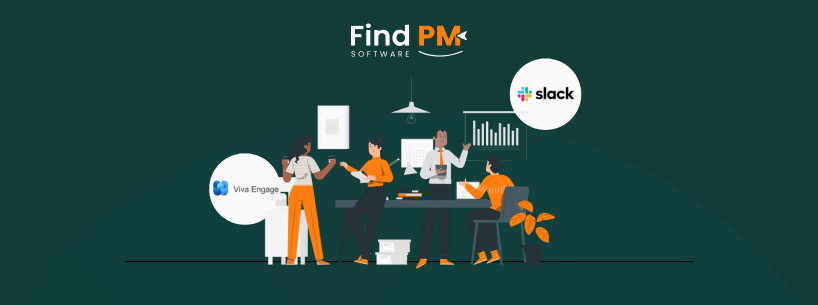
Yammer and Slack are two popular tools designed to enhance communication and collaboration within organizations. While both serve similar purposes, they cater to different needs and offer distinct features. Yammer, developed by Microsoft, functions as an enterprise social network, often likened to "Facebook for the workplace." Slack, a cloud-based platform, focuses on real-time messaging and integrations, making it a go-to for dynamic team collaboration. This yammer vs slack comparison provides a detailed overview of Yammer and Slack, helping you determine which is better suited for your team's requirements.

Yammer, now Viva Engage, is an enterprise social networking platform integrated with Microsoft 365. It enables employees to connect, share information, and collaborate in a secure environment. Designed to foster a sense of community, Yammer allows users to post updates, join groups, and engage in discussions, making it ideal for knowledge sharing and company-wide communication.
Yammer Pros And Cons
Pros:
- Seamless Microsoft Integration: Works effortlessly with Microsoft 365 tools like SharePoint, OneDrive, and Teams
- Social Networking Features: Users can follow colleagues, join groups, and participate in discussions, encouraging engagement
- External Collaboration: Supports external networks for connecting with partners or customers
- Scalability: Well-suited for large enterprises, especially those using Microsoft 365
Cons:
- Limited Real-Time Collaboration: Less effective for immediate, team-specific communication compared to messaging apps
- Potential Overload: Multiple groups and posts can overwhelm users if not managed properly

Slack is a cloud-based team collaboration platform known for its real-time messaging capabilities. It organizes communication into channels, direct messages, and group conversations, streamlining workflows. With over 2,000 app integrations, Slack enhances productivity by connecting with tools like Google Drive and Zoom, making it a versatile choice for teams of all sizes.
Slack Pros And Cons
Pros:
- Real-Time Messaging: Channels and direct messages enable quick, organized communication
- Extensive Integrations: Connects with over 2,000 apps, including Trello, Jira, and Salesforce
- User-Friendly Interface: Clean, intuitive design with a low learning curve
- Flexible Plans: Offers a free tier and scalable paid plans for various team sizes
Cons:
- Notification Overload: Multiple channels can lead to excessive notifications if not configured properly
- Additional Costs for Features: Advanced features like single sign-on require higher-tier plans

Communication
Yammer: Yammer focuses on asynchronous communication, resembling a social media feed where users post updates, share files, and comment. It’s ideal for broadcasting company-wide announcements, sharing non-urgent information, or conducting surveys. However, it’s less suited for instant messaging, where tools like Skype or Teams may be recommended.
Slack: Slack excels in synchronous communication, allowing teams to interact in real time through channels dedicated to specific projects or topics. It reduces email chains by enabling quick file sharing and direct messaging. Slack’s structure ensures only relevant team members are involved, avoiding unnecessary discussions. Its search functionality allows users to quickly retrieve messages or files, enhancing efficiency.
Integration
Yammer: Yammer integrates seamlessly with Microsoft 365 tools, including SharePoint, Outlook, and Dynamics CRM. It also supports third-party apps like Salesforce via APIs, though its integration options are narrower compared to Slack. Yammer’s strength lies in its compatibility with Microsoft’s ecosystem, making it a natural choice for organizations already invested in these tools.
Slack: Slack offers over 2,000 integrations, connecting with tools like Google Drive, Jira, and Zoom. This extensive library allows teams to customize workflows, reducing the need for multiple platforms. Slack’s integrations substitute email and streamline processes, saving time on logins and app switching.
Yammer: Yammer’s interface is simple and intuitive, resembling social media platforms like Facebook or LinkedIn. Users can navigate groups, posts, and messages via a left pane, requiring minimal onboarding. However, the interface may feel cluttered with extensive group activity, and advanced features may require additional setup.
Slack: Slack’s interface is colorful and user-friendly, with channels and direct messages organized in a left pane. Its design supports quick navigation, and features like bots and a help center enhance usability. While the channel-based structure may initially confuse new users, Slack’s onboarding process and templates ease the transition.
Yammer: Yammer’s support is tied to Microsoft 365, offering email, phone, and live support depending on the subscription plan. Users can access a help center with training resources and community forums. Support quality varies by plan, with enterprise users receiving priority assistance.
Slack: Slack provides robust support through a comprehensive help center, community forums, and direct support for paid plans. Features like Slack bots assist with real-time queries, and keyword searches provide quick access to previous cases. Paid plans include ticket, email, and phone support, ensuring responsive assistance.
Yammer: Yammer benefits from Microsoft’s enterprise-grade security, including multi-factor authentication. It complies with various standards, making it suitable for organizations with strict security requirements. However, the basic version may lack advanced admin controls.
Slack: Slack offers robust security features, including ISO/IEC 27001, GDPR compliance, SAML single sign-on, and data encryption. It supports data retention post-service cancellation and Slack Enterprise Key Management (EKM) for enhanced control. These features make Slack a secure choice for diverse organizations.
Yammer: Yammer is accessible on Windows, Mac, iOS, Android, and web-based platforms. Its mobile apps mirror desktop functionality, allowing users to post, comment, and join groups on the go. It’s optimized for enterprises using Microsoft 365 across devices.
Slack: Slack supports Windows, Mac, iOS, Android, and web-based platforms, offering a responsive mobile app for messaging and notifications. Its cross-platform compatibility ensures seamless collaboration, though some advanced features may perform better on desktop.

Microsoft Viva Pricing
Microsoft Viva offers a tiered pricing model designed to enhance employee experience within Microsoft 365. Core features like Viva Connections, Viva Engage, access to learning content in Teams, and personal insights are included with Microsoft 365 enterprise plans at no extra cost. For extended functionality, the Viva Employee Communications and Communities plan is available at $2/user/month (billed annually), adding premium community experiences, crowdsourced Q&A, and campaign management tools. The Viva Workplace Analytics and Employee Feedback plan, priced at $6/user/month, includes organizational insights, leadership dashboards, feedback tools, and AI adoption metrics through apps like Viva Insights, Glint, and Pulse. For a comprehensive solution, the Viva Suite bundles all modules—communications, learning, insights, and feedback—for $12/user/month, offering an integrated, cost-effective option for businesses aiming to boost engagement and productivity.
Slack Pricing
Slack provides several subscription tiers to cater to various team sizes and needs. The Free plan allows for basic messaging and collaboration with limited message history and app integrations. The Pro plan, priced at $8.75 per user per month, offers unlimited message history and app integrations, suitable for small teams. The Business+ plan is priced at $15 per user per month, providing advanced features for larger organizations. For enterprises, custom pricing is available through the Enterprise Grid subscription, which includes enhanced security and administrative controls.
- Large enterprises using Microsoft 365
- Teams focused on company-wide communication and knowledge sharing
- Organizations needing external collaboration networks
- Businesses prioritizing a social media-like interface for engagement
- Teams of all sizes needing real-time collaboration
- Organizations requiring extensive third-party integrations
- Small businesses or startups leveraging the free plan
- Teams managing multiple projects with dynamic communication needs
The choice between Yammer and Slack hinges on your organization’s needs. Yammer is ideal for large enterprises within the Microsoft 365 ecosystem, excelling in asynchronous communication and fostering company culture. Slack is better for teams needing real-time messaging, extensive integrations, and flexibility across platforms. Consider your team’s size, communication style, and existing tools when deciding. Both platforms are powerful, but their strengths cater to different priorities.
